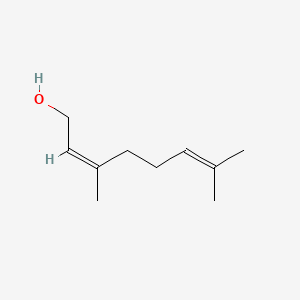| Authors | Title | Published | Journal | PubMed Link |
|---|---|---|---|---|
| Schmidt E et al. | Chemical composition, olfactory analysis and antibacterial activity of Thymus vulgaris chemotypes geraniol, 4-thujanol/terpinen-4-ol, thymol and linalool cultivated in southern France. | 2012 | Nat Prod Commun | pmid:22978238 |
| Kim SH et al. | Geraniol induces cooperative interaction of apoptosis and autophagy to elicit cell death in PC-3 prostate cancer cells. | 2012 | Int. J. Oncol. | pmid:22200837 |
| Vinothkumar V et al. | Geraniol modulates cell proliferation, apoptosis, inflammation, and angiogenesis during 7,12-dimethylbenz[a]anthracene-induced hamster buccal pouch carcinogenesis. | 2012 | Mol. Cell. Biochem. | pmid:22729742 |
| Revay EE et al. | Reduction of mosquito biting pressure by timed-release 0.3% aerosolized geraniol. | 2012 | Acta Trop. | pmid:22750481 |
| Hagvall L et al. | Contact allergy to air-exposed geraniol: clinical observations and report of 14 cases. | 2012 | Contact Derm. | pmid:22681463 |
| Annadurai RS et al. | Next generation sequencing and de novo transcriptome analysis of Costus pictus D. Don, a non-model plant with potent anti-diabetic properties. | 2012 | BMC Genomics | pmid:23176672 |
| Ben Hsouna A and Hamdi N | Phytochemical composition and antimicrobial activities of the essential oils and organic extracts from Pelargonium graveolens growing in Tunisia. | 2012 | Lipids Health Dis | pmid:23216669 |
| Dziadas M and Jeleń H | Influence of glycosidases addition on selected monoterpenes contents in musts and white wines from two grape varieties grown in Poland. | 2011 Jan-Mar | Acta Sci Pol Technol Aliment | pmid:22232525 |
| Marcuzzi A et al. | Geraniol rescues inflammation in cellular and animal models of mevalonate kinase deficiency. | 2011 Jan-Feb | In Vivo | pmid:21282739 |
| Baffi MA et al. | A novel β-glucosidase from Sporidiobolus pararoseus: characterization and application in winemaking. | 2011 | J. Food Sci. | pmid:21819399 |
| Khan MS and Ahmad I | In vitro antifungal, anti-elastase and anti-keratinase activity of essential oils of Cinnamomum-, Syzygium- and Cymbopogon-species against Aspergillus fumigatus and Trichophyton rubrum. | 2011 | Phytomedicine | pmid:21893402 |
| Verma RS et al. | Volatile constituents of essential oil and rose water of damask rose (Rosa damascena Mill.) cultivars from North Indian hills. | 2011 | Nat. Prod. Res. | pmid:21711177 |
| Vieira A et al. | Efficacy of geraniol but not of β-ionone or their combination for the chemoprevention of rat colon carcinogenesis. | 2011 | Braz. J. Med. Biol. Res. | pmid:21445532 |
| Hisamoto K et al. | Hydroxy-group effect on the regioselectivity in a photochemical oxetane formation reaction (the Paternò-Büchi Reaction) of geraniol derivatives. | 2011 | Photochem. Photobiol. Sci. | pmid:21541429 |
| Saha P et al. | Synthesis of oxabicyclo[3.3.1]nonenes and substituted tetrahydropyrans via (3,5)-oxonium-ene reaction. | 2011 | Org. Biomol. Chem. | pmid:21512689 |
| RodrÃguez A et al. | Terpene down-regulation in orange reveals the role of fruit aromas in mediating interactions with insect herbivores and pathogens. | 2011 | Plant Physiol. | pmid:21525333 |
| Katsukawa M et al. | Citronellol and geraniol, components of rose oil, activate peroxisome proliferator-activated receptor α and γ and suppress cyclooxygenase-2 expression. | 2011 | Biosci. Biotechnol. Biochem. | pmid:21597168 |
| Michlmayr H et al. | Characterization of two distinct glycosyl hydrolase family 78 alpha-L-rhamnosidases from Pediococcus acidilactici. | 2011 | Appl. Environ. Microbiol. | pmid:21784921 |
| Arifin AA et al. | The feasibility of growing cells of Saccharomyces cerevisiae for citronellol production in a continuous-closed-gas-loop bioreactor (CCGLB). | 2011 | Bioresour. Technol. | pmid:21835610 |
| Kuwahara Y et al. | Geraniol, E-3,7-dimethyl-2,6-octadien-1-ol, as the alarm pheromone of the sycamore lace bug Corythucha ciliata (Say). | 2011 | J. Chem. Ecol. | pmid:22076683 |
Nerol
Nerol is a lipid of Prenol Lipids (PR) class. The involved functions are known as Odorant, Anabolism, Diastasis, Metabolic Inhibition and Oxidation. Nerol often locates in germ tube. The related lipids are Octanols, Pinene, Hexanols, ethyl butyrate and ethyl hexanoate.
Cross Reference
Introduction
To understand associated biological information of Nerol, we collected biological information of abnormalities, associated pathways, cellular/molecular locations, biological functions, related genes/proteins, lipids and common seen animal/experimental models with organized paragraphs from literatures.
What diseases are associated with Nerol?
There are no associated biomedical information in the current reference collection.
No disease MeSH terms mapped to the current reference collection.
PubChem Associated disorders and diseases
What pathways are associated with Nerol
There are no associated biomedical information in the current reference collection.
PubChem Biomolecular Interactions and Pathways
Link to PubChem Biomolecular Interactions and PathwaysWhat cellular locations are associated with Nerol?
Visualization in cellular structure
Associated locations are in red color. Not associated locations are in black.
Related references are published most in these journals:
| Location | Cross reference | Weighted score | Related literatures |
|---|
What functions are associated with Nerol?
Related references are published most in these journals:
| Function | Cross reference | Weighted score | Related literatures |
|---|
What lipids are associated with Nerol?
Related references are published most in these journals:
| Lipid concept | Cross reference | Weighted score | Related literatures |
|---|
What genes are associated with Nerol?
There are no associated biomedical information in the current reference collection.
What common seen animal models are associated with Nerol?
There are no associated biomedical information in the current reference collection.
